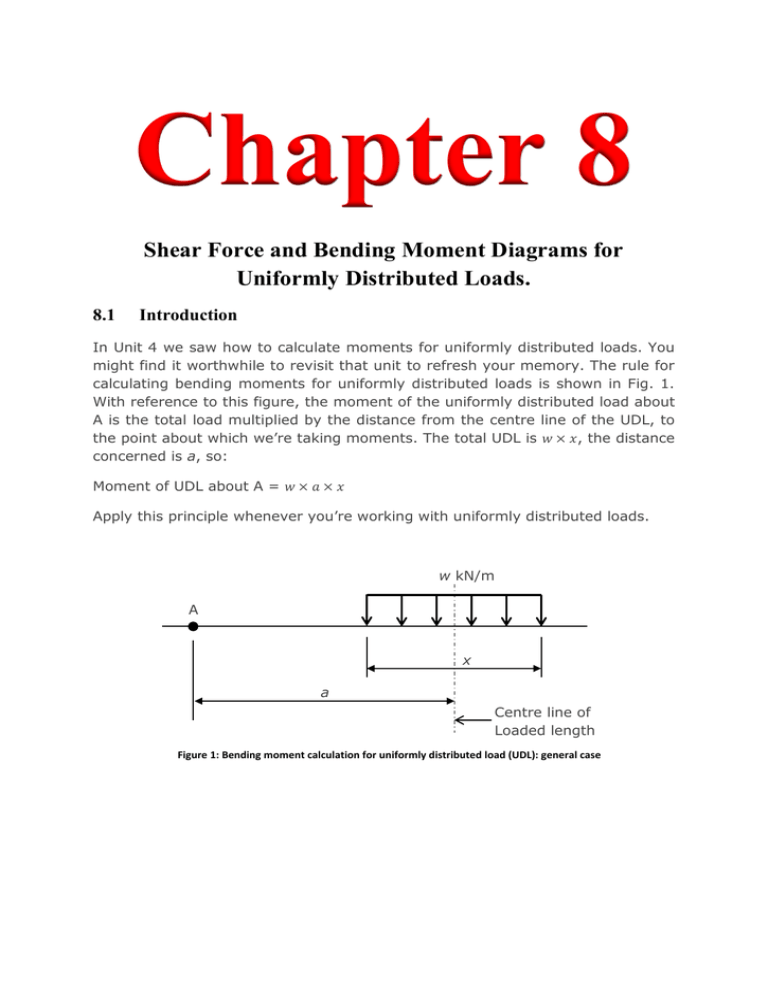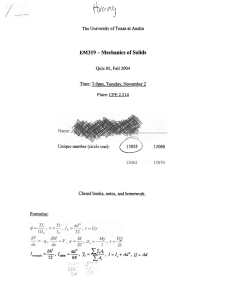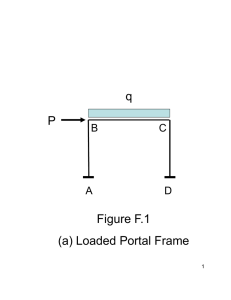Shear Force and Bending Moment Diagrams for Uniformly
advertisement

Chapter 8 Shear Force and Bending Moment Diagrams for Uniformly Distributed Loads. 8.1 Introduction In Unit 4 we saw how to calculate moments for uniformly distributed loads. You might find it worthwhile to revisit that unit to refresh your memory. The rule for calculating bending moments for uniformly distributed loads is shown in Fig. 1. With reference to this figure, the moment of the uniformly distributed load about A is the total load multiplied by the distance from the centre line of the UDL, to the point about which we’re taking moments. The total UDL is , the distance concerned is a, so: Moment of UDL about A = Apply this principle whenever you’re working with uniformly distributed loads. w kN/m A x a Centre line of Loaded length Figure 1: Bending moment calculation for uniformly distributed load (UDL): general case Practical Example 1 Beam AG, shown in figure 2, spans 6 metres. It supports a uniformly distributed load of 4kN/m along its entire length. Draw the shear force and bending moment diagrams. 4 kN/m A B C D E F G 6m RA RG Figure 2: Example 1: Beam Diagram First of all, calculate the reactions. This is easy in this case because of the symmetry of both the beam itself and its loading. Each end reaction will be half the total load on the beam. So ( ) We will now try the metre-by-metre approach – as pioneered in chapter 7 - to drawing the shear force and bending moment diagrams. So, we are going to calculate the shear force and bending moment values at points A, B, C, D, E, F and G. SHEAR FORCES (Remember always look at what’s going on to the left of the point at which you’re trying to calculate shear force.) As before, draw a horizontal straight line representing zero shear force. This will be the base line from which the shear force diagram is drawn. There is nothing to the left of point A, so the shear force at point A is zero. If we go a very small distance (say 2 millimetres)to the right of A, there is now a 12 kN upward force (the reaction at A) to the left of the point we’re considering. So the shear force at this point is 12 kN. We can represent this effect by a vertical straight line at point A, starting at the zero force base line and going up to a point representing 12 kN. Each of points B, C, D, E, F and G has this 12 kN upward force to the left of it (i.e. the reaction at point A), but they also have downward forces to the left. Let’s consider each of these points in turn. Point Upward Force Downward Force Shear force B 12kN (4kN/m x 1m) =4kN 12 – 4 = 8kN C 12kN (4kN/m x 2m) = 8kN 12 – 8 = 4kN D 12kN (4kN/m x 3m) = 12kN 12 – 12 = 0kN E 12kN (4kN/m x 4m) = 16kN 12 – 16 = – 4kN F 12kN (4kN/m x 5m) = 20kN 12 – 20 = – 8kN G 12kN (4kN/m x 6m) = 24kN 12 – 24 = – 12kN At point G, there is an upward reaction of 12kN. So the net shear force at G will be – 12 + 12 = 0kN. These values can be plotted on our shear force diagram in Fig. 3 (b). Bending Moments Once more, we will be looking solely at forces and moments to the left of the point we’re considering. As in earlier examples, we will calculate the momnet at each point, remembering that: Clockwise moments are positive, and anticockwise moments are neagtive; Distances are measured from the force concerned to the point considered. Point Bending Moment Calculation Bending Moment (kN.m) A +(12kN x 0m) 0 B +(12kN x 1m) – (4kN/m x 1m x 0.5m) 12 – 2 = 10 C +(12kN x 2m) – (4kN/m x 2m x 1m) = 24 – 8 = 16 D +(12kN x 3m) – (4kN/m x 3m x 1.5m) = 36 – 18 = 18 E +(12kN x 4m) – (4kN/m x 4m x 2m) = 48 – 32 = 16 F +(12kN x 5m) –(4kN/m x 5m x 2.5m) = 0 – 50 = 10 G +(12kN x 6m) – (4kN /m x 6m x 3m) = 72 – 72 = 0 The bending moment diagram is drawn in Fig. 3 (c). 4 kN/m A B C D E G F 6m RA = 12kN RG = 12kN (a) Beam Diagram 12 8 12 4 0 4 12 8 (b) Shear Force Diagram 12 0 0 10 10 16 18 16 (c) Bending Moment Diagram Figure 3: Practical Example 1 Graphical interpretation 8.2 The Shape of Shear Force and Bending Moment Diagrams where Uniformly Distributed Loads are Present If you examine the shape of the shear force and bending moment diagrams in Fig. 3 you will notice the following features: The shear force diagram comprises sloping straight lines. The bending moment diagram is curved (parabolic). In general, where a beam is loaded with uniformly distributed loads along all or part of its length, the shear force and bending moment diagrams along the part of the beam concerned have the above features. To summarise: where a beam experiences uniformly distributed loads, the shear force diagram will compromise sloping straight lines and the bending moment diagram will be curved. Shear Force and Bending Moment Diagrams for Standard Cases There are three standard cases of beam loading that are so common that the reader would be well advised to commit the results to memory. These are: Beam with a central point load; Beam with a non-central point load; Beam carrying a uniformly distributed load over its entire length. These cases, along with their respective shear force and bending moment diagrams, are shown in Figs. 4 - 6. Using the techniques discussed above, you should be able to obtain these reactions and shear force and bending moment values for yourself. P A B C L RA = P/2 (a) Beam Diagram RB = P/2 P/2 P/2 0 0 0 P/2 P/2 (b) Shear Force Diagram 0 0 PL/4 (c) Bending Moment Diagram Figure 4: Standard case 1: Shear force and bending moment diagrams for a beam carrying a central point load P b a A C B L RA = Pb/L (a) Beam Diagram RB = Pa/L Pb/L Pb/L 0 0 Pa/L Pa/L (b) Shear Force Diagram 0 0 Pab/L (c) Bending Moment Diagram Figure 5: Standard case 2: Shear force and Bending moment diagrams for a beam carrying a non-central point load Note that the result for the maximum bending moment in a beam with a uniformly distributed load over its entire length ( commonly used in practise. ) is particularly w kN/m A B C Lm RA =(𝑤𝐿 ) RB = (a) Beam Diagram (𝑤𝐿 (𝑤𝐿 ) ) 0 (𝑤𝐿 ) (b) Shear Force Diagram 0 0 (𝑤𝐿 ) (c) Bending Moment Diagram Figure 6: Standard case 3: Shear force and bending moment diagrams for a beam carrying distributed load over its entire length More Examples Involving Uniformly Distributed Loads Draw the shear force and bending moment diagrams for each of the beams shown in Fig. 7. The solutions are given during the class. 6 kN/m B C A 3m 3m RA RB 5 kN (a) 50 kN 10 kN/m 3 kN/m A C B 4m 6m RA 5m (b) RC 5 kN 5 kN 12 kN/m A C B 3m RA 1m E D 1m 1m (c) Figure 7: Further shear force and bending moment diagram examples RE



